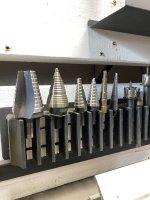Do you ever use a "coolant" like washer fluid on regular mild steel or do you go back to the oils?
Never any 'lubricating oils'. They lubricate the cutting edge.

It's the tool that does the work, not brute or inefficient horsepower behind it. Oil-like cutting fluids have various familiar viscosity/thickness but its about surface tension on a molecular micro-level that we don't see. (I do my my turning and milling dry except for brand name tapping fluids like Anchor Lube, Cool Tool II), or perhaps a spritz of WD rust preserver machining yellow metals
not bearing bronzes. Bed-rail is like key stock, in that you can go right through either with a hack saw if you go slow and don't let them get more than warm to the touch. If you rush, you'll end up using a cutoff wheel to finish.

(high carbon content provides work-hardening properties)
Classic and rarely challenged by the best of modern chemistry cutting/cooling 'lubes' remain the unhealthy white lead, and the oft funky-smelling rendered/drained pork fat.
The waxy stick-type modern things are just superb, period. High on efficiency, low on mess/cleanup. With any good cutting fluid, friction is reduced where chips roll up spiral drill flutes* or out of reamer, broach, or saw-tooth 'gullets' but that low surface tension is letting the cutting edge bite into the workpiece like it wants to by design. Ask anybody who uses them!
Anyway, to answer, the 'glass cleaners' are as 'good' at cooling as plain water, letting teeth and cutting edges bite in while having a high specific heat to cool as best as can be imagined. What they offer us is cheap but top results and easy to clean up where they might have to be splashed on. So out in the shop/garage, barn where we can best use them there's rarely evidence of use after a coffee break. I've dribbled water as a helper to demonstrate how much easier bedframe 'drills', ... and how many holes a HFT drill-bit can do through bed-rail steel by just net letting it get hot
*A TiN (electro-vapor deposited gold-colored coating) is there to lube/cool the chip as it curls into the flute. When such a drill is resharpened, we 'grind our way up' to a new portion right behind the lip. Grinding it away from the 'relief/clearance' takes nothing away from the coating's purpose, so sharpen & use 'em vs ever toss 'em out. "Read the chip" to see how you're doing and never assume that WFO is a proper drilling speed. That's really for 1/8" and smaller drilling.
Portable progress tip:
Revised: With a proper/prescribed product ... A Grizzly or ebay 'Mist nozzle with magnetic base' only needs a tank, and few cfm of air at 40 or so PSI (HFT airbrush compressor, etc) to set up mist cooling on about any job. (got mag drill?)

Tops if shop or job's 'atmosphere' demands the least overspray, and only go in for the very best (Lincoln, Miller), Fog Buster equals all the advantages of mist or flood coolant except the former's cost to buy in.


 )
)